Susan Price's Blog: Susan Price's Nennius Blog, page 17
November 2, 2012
Post-Haste
I've got to be brief this week, as I'm the middle of various work deadlines, and also, am not feeling too well. Like a lot of other people, I've a bit of a cold, a bit of sore throat, bit of headache... And it's Davy's birthday meal-out this weekend, too, so I'm saving myself for that.
First, I'd like to share this short film with you. I've copied it from YouTube, where it was posted by the BBC Wildlife Trust, but it was filmed and sent to the BBC by a friend of mine. I'm not saying where it was filmed, for fear that government sharp-shooters get to hear of it, but it was somewhere in the deep, dark depths of the West Midlands concrete wilderness.
So there's hope that even if the government stupidly persist in killing one of our oldest native species, despite very little evidence that doing so will stop the spread of TB in cattle, badgers will simply join foxes in our backgardens. This one already co-exists with a family of foxes and several cats.
And then there's this lad:-
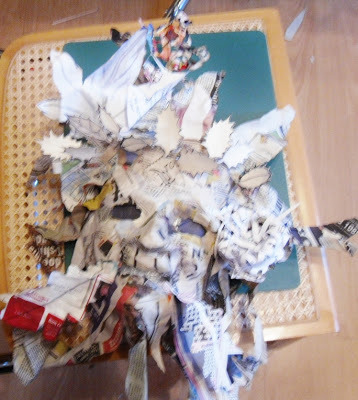
Not the best photo, I admit. He now has a frost nibbled maple leaf in his crown - an English maple, Joan, sorry - and oak leaves sprouting from the corners of his mouth in best Green Man style. A bird of a species unknown to science has built a nest against his right cheek. There will be eggs in it, but at the moment the glue's still drying and I don't want to add extra weight. I spend as much time looking at him and thinking as I do adding anything. I'm thinking: apple-blossom above the nest, and an apple against his left cheek, opposite the nest. Too obvious? Maybe. But then, the seasons are pretty obvious. Not much point trying to be original about them. As soon as I get my hands on some paint - couldn't find any in my local poundstore, Madwippet - I'll add some colour, just to make it easier to tell what I'm doing.
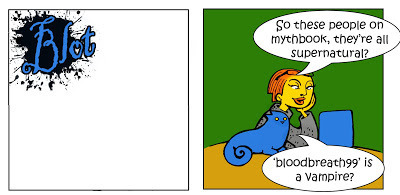
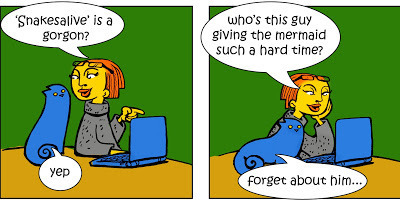


First, I'd like to share this short film with you. I've copied it from YouTube, where it was posted by the BBC Wildlife Trust, but it was filmed and sent to the BBC by a friend of mine. I'm not saying where it was filmed, for fear that government sharp-shooters get to hear of it, but it was somewhere in the deep, dark depths of the West Midlands concrete wilderness.
So there's hope that even if the government stupidly persist in killing one of our oldest native species, despite very little evidence that doing so will stop the spread of TB in cattle, badgers will simply join foxes in our backgardens. This one already co-exists with a family of foxes and several cats.
And then there's this lad:-

Not the best photo, I admit. He now has a frost nibbled maple leaf in his crown - an English maple, Joan, sorry - and oak leaves sprouting from the corners of his mouth in best Green Man style. A bird of a species unknown to science has built a nest against his right cheek. There will be eggs in it, but at the moment the glue's still drying and I don't want to add extra weight. I spend as much time looking at him and thinking as I do adding anything. I'm thinking: apple-blossom above the nest, and an apple against his left cheek, opposite the nest. Too obvious? Maybe. But then, the seasons are pretty obvious. Not much point trying to be original about them. As soon as I get my hands on some paint - couldn't find any in my local poundstore, Madwippet - I'll add some colour, just to make it easier to tell what I'm doing.



Published on November 02, 2012 17:05
October 26, 2012
A Conversation With Gillian McClure
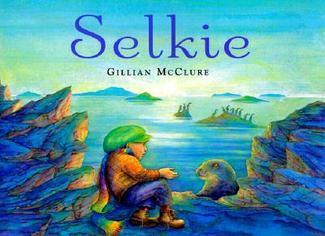 'Selkie' written and illustrated by Gillian McClure, published by Plaister Press
'Selkie' written and illustrated by Gillian McClure, published by Plaister Press This is the first in an occasional series of conversations with friends - many of whom will be writers, but not all.
My first guest is the award-winning writer and illustrator, Gillian McClure, who I met when we gave a talk together at the Children's Writers' and Illustrators' Conference in September this year.
 Susan Price Sue Price: I used to draw a great deal as a child and teenager, and was considered talented - but with me, writing took over, and I drew less and less. Obviously, with you, the two skills went more hand-in-hand. Can you even imagine a life without drawing?
Susan Price Sue Price: I used to draw a great deal as a child and teenager, and was considered talented - but with me, writing took over, and I drew less and less. Obviously, with you, the two skills went more hand-in-hand. Can you even imagine a life without drawing?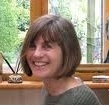 Gillian McClureGillian McClure: Writing nearly took over for me about ten years ago, when my agent wanted me to write little stories with black and white illustrations for the 7 plus age group because they were easier than picture books to get published. But I was half hearted. I loved colour and so I made a conscious decision not to move away from picture books however hard the going was. Now when I’m with writers I don’t feel wholly a writer and when I’m with illustrators I don’t feel wholly an illustrator. I only feel whole when putting text and image together in a picture book.
Gillian McClureGillian McClure: Writing nearly took over for me about ten years ago, when my agent wanted me to write little stories with black and white illustrations for the 7 plus age group because they were easier than picture books to get published. But I was half hearted. I loved colour and so I made a conscious decision not to move away from picture books however hard the going was. Now when I’m with writers I don’t feel wholly a writer and when I’m with illustrators I don’t feel wholly an illustrator. I only feel whole when putting text and image together in a picture book.Sue: So obviously, no, you can’t imagine not drawing and painting! I sometimes get really fed up with writing – it can be a slog at times – and I tell myself that if I had a change of earning a living some other way, I’d never write another word. I'm not sure it's true. I think, after about three weeks, at the longest, I’d start to get that looming, anxious, twitchy feeling – and I would have to write again. Ever experienced anything like that?
Gillian: Oh yes, I crave a normal 9-5 job with weekends off, a salary and a pension – a normal life like everyone else. But like you an anxiety drives me on and I have to keep on entering that long dark tunnel with a chink of light at the end – the finished book. Sue: Could you tell us more about the process of making a picture-book?
Gillian: I start with an image or just a feeling in my head, then I attach a sentence or two to it – like an accompanying tune and then I grow this into the first draft of a story. I do this first draft on post-its – to keep the word count down and because I can stick them in a blank 32 page dummy book and move them about at the page turns. This all helps get the rhythm and pace of the story to work. Writing a picture book text is a bit like writing a poem because of the tight framework. The best texts are like a long single sentence flowing from page to page. The second draft occurs when I add the images; words can be cut back if the pictures are telling the same bit of the story. This is the stage I really enjoy, integrating word and image and getting the sentences to follow the movement of the pictures, as in this early rough from The Little White Sprite -
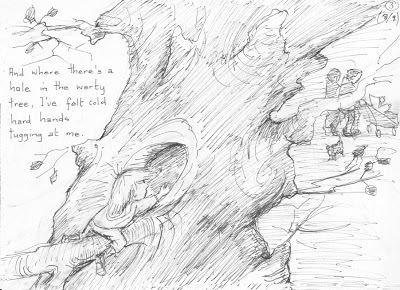
- which ends up like this in the finished book.
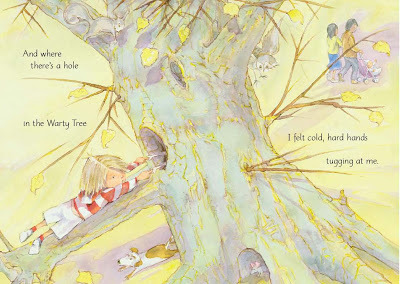 If I’m illustrating someone else’s story, it’s a bit like coming in on the process at the second draft stage but being unable to play around with the words. I can add something to them though – a visual sup plot. Once I added a small dog to Mary Arrigan’s Mario’s Angels when there was no dog mentioned in the text. Neither Mary nor the editor objected to the story having a gate crasher.
If I’m illustrating someone else’s story, it’s a bit like coming in on the process at the second draft stage but being unable to play around with the words. I can add something to them though – a visual sup plot. Once I added a small dog to Mary Arrigan’s Mario’s Angels when there was no dog mentioned in the text. Neither Mary nor the editor objected to the story having a gate crasher.
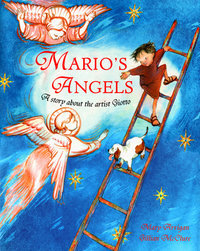
Sue Price: I love the gate-crashing dog! And I loved your account of making a picture book. It confirmed what I've often suspected: that it's like writing a poem. Yet I think people often look down on picture books as 'just for children', which is shocking on so many levels. First, it's the disregard for the artistry in them, both in words and pictures - and then, I think of my cousin, who teaches languages and reading, and says that learning to read is like an iceberg: 90% is unseen. He says that a child who comes from a home where they've been involved in conversations, been told stories, and have been read stories, is years ahead of a child who hasn't had these experiences when it comes to learning to read. Because, he says, socialisation and social convention plays a huge part both in learning to read and being motivated to read. Take all that together, and there's hardly an art form worth more respect than a beautiful, engaging picture book.
Gillian:What an interesting simile – learning to read being like an iceberg. I do feel it’s a huge responsibility writing for children. And there needs to be consideration for the poor Mum and Dad who are made to read the same book night after night (in the families where there are bedtime stories). A picture book text has to sound good when read aloud, even when it's in graphic format like Zoe's Boat (below) making it a bit like a poem.
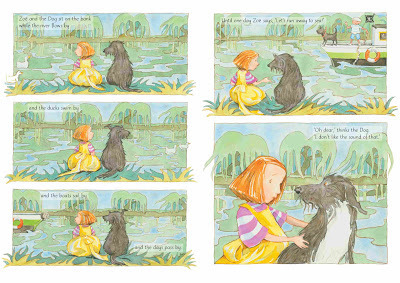 SUE: A last question, then. What's your favourite of the picture books you've done? The one that comes closest to your ideal of text and pictures working together to make a beautiful whole?
SUE: A last question, then. What's your favourite of the picture books you've done? The one that comes closest to your ideal of text and pictures working together to make a beautiful whole?GILLIAN: I think I would say the new one, We’re Going to Build a Dam, to be published in March 2013. Here I’ve gone further than before to make the typeface part of the illustration as well as the text. For example, on a page where the dam breaks and there’s the word ‘CRACK!’ the typographical designer, Lisa Kirkham, actually makes the letters split apart. And where the text says ‘...a small stream rippling round a boulder’ the type does that movement in the illustration.
The book, We’re Going to Build a Dam, will be published by Plaister Press, which Gillian McClure started.
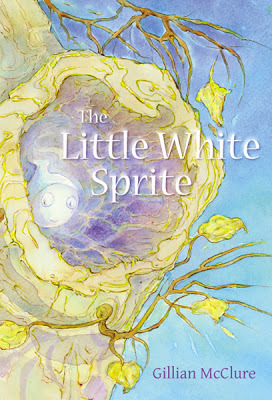 The Little White Sprite by Gillian McClure
The Little White Sprite by Gillian McClure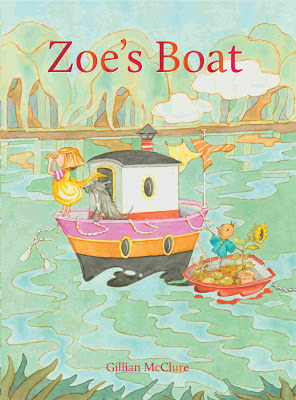 Zoe's Boat by Gillian McClure.
Zoe's Boat by Gillian McClure. 

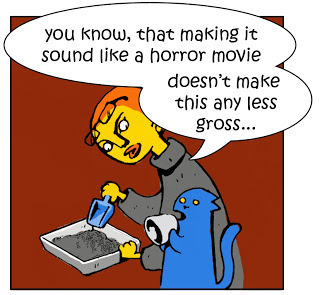
Published on October 26, 2012 16:05
October 19, 2012
Clowns and Green Men
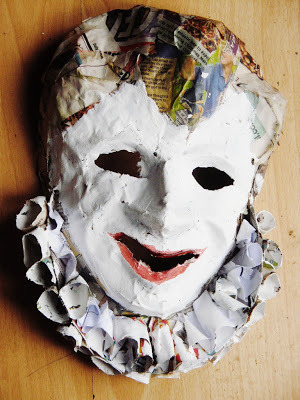
Did nothing this week, except the usual noodling around with blogs, emails and so on. Well, did write the beginning of a new story that I promised my agent.
I thought I'd put up the clown mask I've been playing around with. I partly painted it with white acrylic, but as I don't have much paint and no brush (I used my fingers) things haven't gone very far. The lips are coloured with a felt-tipped pen, but I'm not happy with them. Acrylic would be better, but I was so overwhelmed with the choice of paints that I ended up not buying any. The clown is based on portraits of Grimaldi - I wanted to avoid the Ronald MacDonald look - and his hair should be blue. There should be bright red triangles painted on his cheeks too. I don't know if I'll bother to finish him.
I started playing around with the Green Man too. My 'studio is one corner of my kitchen table, and while I'm waiting for the kettle to boil, I seize bits of paper and card and work on it for ten minutes at a time. It started like this -
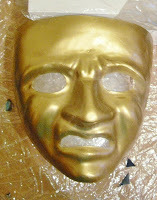
A cheap plastic mask of tragedy, which I coated with vaseline. After lots of paste and torn paper, it turned into this -
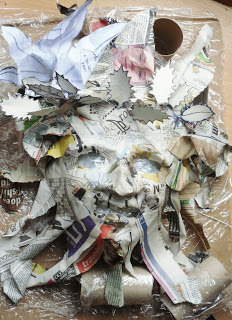 This detail of the top left hand corner shows the cardboard holly leaves, and a crumpled paper sycamore leaf,
This detail of the top left hand corner shows the cardboard holly leaves, and a crumpled paper sycamore leaf,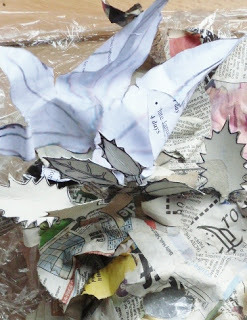 It's all made out of old newspapers, cardboard boxes, unwanted junk mail. At the moment I'm trying to make a small bird's nest by layering paper around a small (greased) measuring cup. As I want to keep the whole thing light, I'll have to find something I can model acorns and hazel-nuts around. I am looking at household objects and bits of rubbish with a speculative eye.
It's all made out of old newspapers, cardboard boxes, unwanted junk mail. At the moment I'm trying to make a small bird's nest by layering paper around a small (greased) measuring cup. As I want to keep the whole thing light, I'll have to find something I can model acorns and hazel-nuts around. I am looking at household objects and bits of rubbish with a speculative eye.From Green Men to Blue Cats...
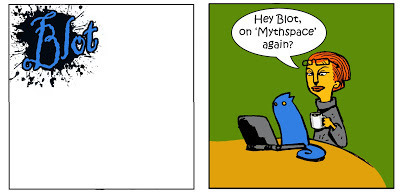
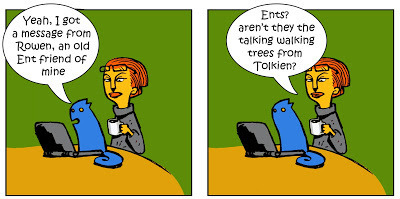
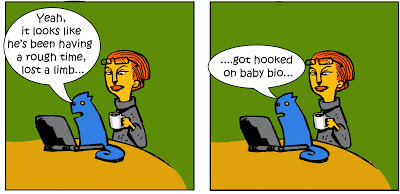
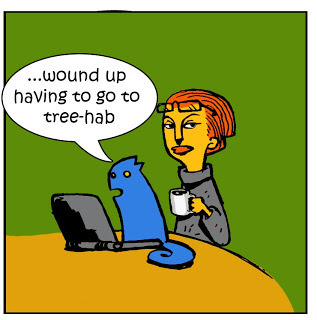
Published on October 19, 2012 16:05
October 12, 2012
Manx Giants
Last Sunday, I went over to the Isle of Man, on a working holiday, coming back in the early hours of Wednesday morning.
 Alan Hess It was great fun. I stayed with my cousin, Alan Hess, the kindest, most patient and considerate of hosts. I'm doing some work for Alan, and the trip was about that, but when we weren't working, Alan gave us a tour of the island, which he knows very well, having lived there for twenty years, before he moved to Switzerland. He's proud to say that he's progressed from being 'a Come-Over' to a 'When-I' (somebody who's succeeded in becoming accepted in the Manx community, but who constantly says, 'When I lived in England... when I...)
Alan Hess It was great fun. I stayed with my cousin, Alan Hess, the kindest, most patient and considerate of hosts. I'm doing some work for Alan, and the trip was about that, but when we weren't working, Alan gave us a tour of the island, which he knows very well, having lived there for twenty years, before he moved to Switzerland. He's proud to say that he's progressed from being 'a Come-Over' to a 'When-I' (somebody who's succeeded in becoming accepted in the Manx community, but who constantly says, 'When I lived in England... when I...)
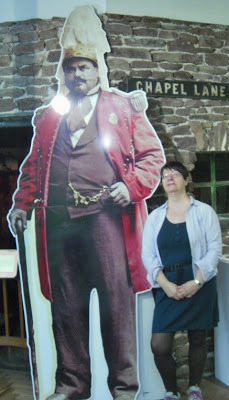 The Giant and me We visited the Manx Giant, Arthur Caley, and Alan introduced me to 'the Crocodile Dundee of the Isle of Man', John 'Dog' Callister, who, Alan said, 'knows everything about Man.' He's an expert on its wild-life and knows much of its history and traditions. John gave me a traditional 'bumbee cage', together with an instruction sheet on how to make one.
The Giant and me We visited the Manx Giant, Arthur Caley, and Alan introduced me to 'the Crocodile Dundee of the Isle of Man', John 'Dog' Callister, who, Alan said, 'knows everything about Man.' He's an expert on its wild-life and knows much of its history and traditions. John gave me a traditional 'bumbee cage', together with an instruction sheet on how to make one.
It's an old Manx belief, it seems, that bumbees, or bumble-bees, were bad fairies, who'd been turned into bees as a punishment. Children would weave these cages from six rushes, but leave the top open. When they spotted a bee in a flower, they would put the open end of the cage over the flower, and so catch the bee, trapping it inside by completing the cage. Shaking the cage would make the bee hum.
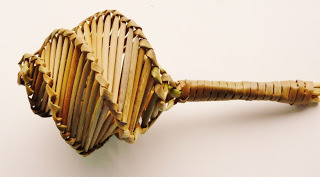 The Bumbee Cage When the children had gone to bed, their parents would undo the cage, let the bee go, and replace it with a pebble before weaving the cage closed again. Next morning, they would tell the child that the bad fairy had learned its lesson, so its powers had been restored, and it had escaped. I can only imagine quite a few parents and children were stung.
The Bumbee Cage When the children had gone to bed, their parents would undo the cage, let the bee go, and replace it with a pebble before weaving the cage closed again. Next morning, they would tell the child that the bad fairy had learned its lesson, so its powers had been restored, and it had escaped. I can only imagine quite a few parents and children were stung.
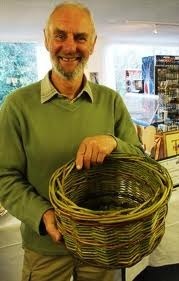 John Dog with more handiwork John's bumbee cage is a lovely thing, and it had three little orangey periwinkle shells inside to make the noise. I might try to make a cage for bad fairies out of drinking straws, following the printed instructions John also gave me. (I don't know where I would find any reeds.)
John Dog with more handiwork John's bumbee cage is a lovely thing, and it had three little orangey periwinkle shells inside to make the noise. I might try to make a cage for bad fairies out of drinking straws, following the printed instructions John also gave me. (I don't know where I would find any reeds.)
John also told me that periwinkle shells make excellent whistles, if you tuck them down between your knuckles and blow into them. Must try it next time I have a periwinkle shell. (I'm not undoing my bumbee cage.)
Alan and I tried to make a film of me telling a story for an event which is taking place in schools all over Switzerland in November: a story-telling evening. Some children will be camping out and listening stories round the camp-fire. Alan and his wife, Ulrike (who is the founder and head of their school) decided to play me as their trump-card - a real, live, English writer and story-teller, telling a story in English, via Skype.
Our meeting was partly to talk over stories and decide on one, and partly to try and record the story on web-cam, as a back-up in case something goes wrong. We staged the scene in Alan's old cottage, using strategically placed reading lamps and candles to give an impression of story-telling by candle-light, and we made three attempts. Every time, the voice was out of synch with the visuals. I was losing concentration, and not giving my best, so we gave up. Alan may be able to tweak the film, but I shall see if I can make my own film. (But am also very happy to tell the story by live link.)
We also talked about SFL, or Systemic Functional Linguistics, which Alan is extremely keen on, and I can see why. (My cousin is a very talented man. He started as - and remains - an excellent musician. He also worked for many years in IT, though he modestly insists that he is no longer up-to-date with the wonderful world of computers. He speaks fluent German - so fluent that northern Germans think he comes from south Germany, and southern Germans think he comes from the north. He now teaches special needs children in Switzerland, a job he absolutely, radiantly loves. Recently he's been spreading the word about SFL, attending conferences, and setting up his Moodle site.
SFL, or Functional Grammar, deserves a blog of its own, but it can be briefly described as a way of teaching languages and reading in much the same way as a small child naturally learns to speak its own language. Suffice to say that Alan had me speaking my own German sentences in a few minutes - and I have always considered myself to have the linguistic talent of a brick.
Er was dunkel und kalt, und eine alte Frau sass neben ihren fuer.
Not perfect, but then, a child's first attempts at speaking never are. It's the constant, repeated corrections of the parent that teach a child its language's grammar - which it learns with incredible speed - and not the reciting of irregular verbs, and learning the plu-perfect.
As Alan says, "Plenty of people say to their children, 'We say, "It is," not "It are," but no one ever tells their two-year old, "There'll be no misuse of the subjunctive in this house!"'
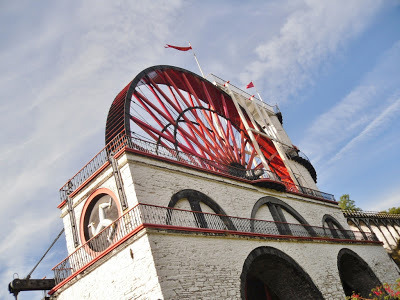 The Laxey Wheel
The Laxey Wheel
And Blott in 'Box'
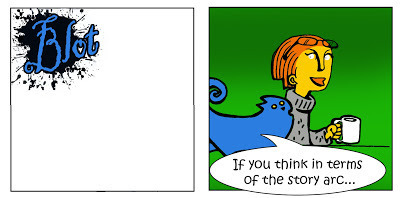
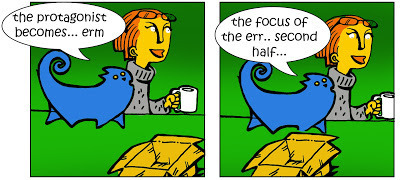
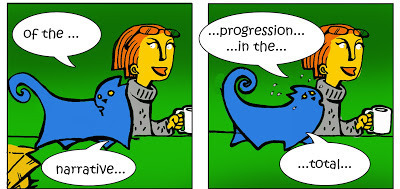
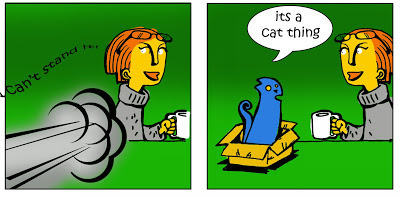

 Alan Hess It was great fun. I stayed with my cousin, Alan Hess, the kindest, most patient and considerate of hosts. I'm doing some work for Alan, and the trip was about that, but when we weren't working, Alan gave us a tour of the island, which he knows very well, having lived there for twenty years, before he moved to Switzerland. He's proud to say that he's progressed from being 'a Come-Over' to a 'When-I' (somebody who's succeeded in becoming accepted in the Manx community, but who constantly says, 'When I lived in England... when I...)
Alan Hess It was great fun. I stayed with my cousin, Alan Hess, the kindest, most patient and considerate of hosts. I'm doing some work for Alan, and the trip was about that, but when we weren't working, Alan gave us a tour of the island, which he knows very well, having lived there for twenty years, before he moved to Switzerland. He's proud to say that he's progressed from being 'a Come-Over' to a 'When-I' (somebody who's succeeded in becoming accepted in the Manx community, but who constantly says, 'When I lived in England... when I...) The Giant and me We visited the Manx Giant, Arthur Caley, and Alan introduced me to 'the Crocodile Dundee of the Isle of Man', John 'Dog' Callister, who, Alan said, 'knows everything about Man.' He's an expert on its wild-life and knows much of its history and traditions. John gave me a traditional 'bumbee cage', together with an instruction sheet on how to make one.
The Giant and me We visited the Manx Giant, Arthur Caley, and Alan introduced me to 'the Crocodile Dundee of the Isle of Man', John 'Dog' Callister, who, Alan said, 'knows everything about Man.' He's an expert on its wild-life and knows much of its history and traditions. John gave me a traditional 'bumbee cage', together with an instruction sheet on how to make one.It's an old Manx belief, it seems, that bumbees, or bumble-bees, were bad fairies, who'd been turned into bees as a punishment. Children would weave these cages from six rushes, but leave the top open. When they spotted a bee in a flower, they would put the open end of the cage over the flower, and so catch the bee, trapping it inside by completing the cage. Shaking the cage would make the bee hum.
 The Bumbee Cage When the children had gone to bed, their parents would undo the cage, let the bee go, and replace it with a pebble before weaving the cage closed again. Next morning, they would tell the child that the bad fairy had learned its lesson, so its powers had been restored, and it had escaped. I can only imagine quite a few parents and children were stung.
The Bumbee Cage When the children had gone to bed, their parents would undo the cage, let the bee go, and replace it with a pebble before weaving the cage closed again. Next morning, they would tell the child that the bad fairy had learned its lesson, so its powers had been restored, and it had escaped. I can only imagine quite a few parents and children were stung. John Dog with more handiwork John's bumbee cage is a lovely thing, and it had three little orangey periwinkle shells inside to make the noise. I might try to make a cage for bad fairies out of drinking straws, following the printed instructions John also gave me. (I don't know where I would find any reeds.)
John Dog with more handiwork John's bumbee cage is a lovely thing, and it had three little orangey periwinkle shells inside to make the noise. I might try to make a cage for bad fairies out of drinking straws, following the printed instructions John also gave me. (I don't know where I would find any reeds.)John also told me that periwinkle shells make excellent whistles, if you tuck them down between your knuckles and blow into them. Must try it next time I have a periwinkle shell. (I'm not undoing my bumbee cage.)
Alan and I tried to make a film of me telling a story for an event which is taking place in schools all over Switzerland in November: a story-telling evening. Some children will be camping out and listening stories round the camp-fire. Alan and his wife, Ulrike (who is the founder and head of their school) decided to play me as their trump-card - a real, live, English writer and story-teller, telling a story in English, via Skype.
Our meeting was partly to talk over stories and decide on one, and partly to try and record the story on web-cam, as a back-up in case something goes wrong. We staged the scene in Alan's old cottage, using strategically placed reading lamps and candles to give an impression of story-telling by candle-light, and we made three attempts. Every time, the voice was out of synch with the visuals. I was losing concentration, and not giving my best, so we gave up. Alan may be able to tweak the film, but I shall see if I can make my own film. (But am also very happy to tell the story by live link.)
We also talked about SFL, or Systemic Functional Linguistics, which Alan is extremely keen on, and I can see why. (My cousin is a very talented man. He started as - and remains - an excellent musician. He also worked for many years in IT, though he modestly insists that he is no longer up-to-date with the wonderful world of computers. He speaks fluent German - so fluent that northern Germans think he comes from south Germany, and southern Germans think he comes from the north. He now teaches special needs children in Switzerland, a job he absolutely, radiantly loves. Recently he's been spreading the word about SFL, attending conferences, and setting up his Moodle site.
SFL, or Functional Grammar, deserves a blog of its own, but it can be briefly described as a way of teaching languages and reading in much the same way as a small child naturally learns to speak its own language. Suffice to say that Alan had me speaking my own German sentences in a few minutes - and I have always considered myself to have the linguistic talent of a brick.
Er was dunkel und kalt, und eine alte Frau sass neben ihren fuer.
Not perfect, but then, a child's first attempts at speaking never are. It's the constant, repeated corrections of the parent that teach a child its language's grammar - which it learns with incredible speed - and not the reciting of irregular verbs, and learning the plu-perfect.
As Alan says, "Plenty of people say to their children, 'We say, "It is," not "It are," but no one ever tells their two-year old, "There'll be no misuse of the subjunctive in this house!"'
 The Laxey Wheel
The Laxey WheelAnd Blott in 'Box'




Published on October 12, 2012 16:05
October 5, 2012
As He Would Draw It
'...He falls to such perusal of my faceAs he would draw it.'
 The mask former
The mask former
Starting with a quote from 'Hamlet', eh? Sure to knock 'em dead.
I was very struck by those lines when I first read 'Hamlet' as a teenager.
I spent a lot of time drawing then, often from life. I knew that, although you might think you were closely observing something, you never really looked at anything until you tried to draw it. The relationships of one part to another, the density of a shadow, the texture, the angles, the precise delination of a curve...
The curves of the Oseberg or Gokstad ships will break your heart. I know: I've tried to draw them.
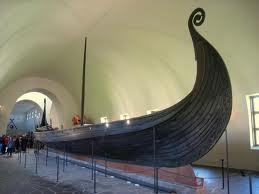 The Oseberg Ship Was Shakespeare an artist, then, as well as a playwright?
The Oseberg Ship Was Shakespeare an artist, then, as well as a playwright?
But what really brings on these thoughts is my Green Man project. I wrote here some months ago that I'd woken up one morning - without ever having any such thought before in my life as far as I can remember - thinking: 'You should make a Green Man mask out of papier-mache.' And then my brother posted that he'd had much the same thought at about the same time.
Those sort of things tend to stick in your head.
I've been busy, and haven't actually ripped up one bit of paper for the Green Man, but I have been thinking about him a lot. A lot. And one happy side-effect of this has been an increase in the intensity of my observation. When I go out for a walk now, it's not just a bit of exercise in the fresh air - it's research.
I'm perusing things as I would make them.
I'm noticing the different veinings and textures of leaves. Some have plump, pillowy leaves with grooves between the veins. Others are flatter and smoother, but grained. There are pinked edges and smooth edges. Hazel leaves are almost circular, not 'leaf-shaped' at all.
I'm noticing the different ways they spring from their twig or stem; how they grow in rosettes or spirals.
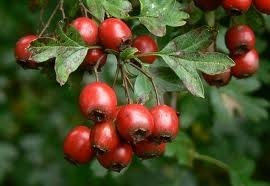 I'm studying, with great interest, the dead stalks and seed-heads standing in the hedgerows. I've always enjoyed the brilliant red berries, but now I'm seeing how many different shapes of them there are.
I'm studying, with great interest, the dead stalks and seed-heads standing in the hedgerows. I've always enjoyed the brilliant red berries, but now I'm seeing how many different shapes of them there are.
I imagine botanists and gardeners enjoy this pleasure in just looking all the time. Perhaps people fascinated by other things do too - people who're enthralled, say, by the study of beetles and other small cattle. But it's a pleasure I'd mislaid somewhat since, all those years ago, I used to stare at things, pencil in hand, hard enough to bore a hole in them.
Whether or not I can reproduce any of these leaves and things remains to be seen - but even if I can't, I'll still have enjoyed this renewed pleasure in just looking. Dying leaves, lemon yellow with splotches and spots of green. Bramble leaves of a deep, glowing maroon red, that you'd think could never be natural, but is.
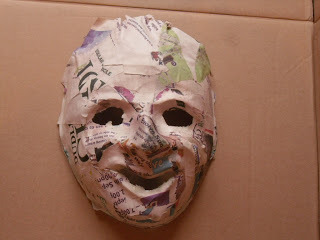 In the meantime, I'm approaching the Green Man with due caution, by having a trial run at something else, just to see what I can learn. I'm using a cheap plastic mask (top) as a form. Can you tell what it is yet?
In the meantime, I'm approaching the Green Man with due caution, by having a trial run at something else, just to see what I can learn. I'm using a cheap plastic mask (top) as a form. Can you tell what it is yet?
The big news of the week, as far as I'm concerned, is that my agent says that she's enjoying Sterkarm 3, and will be in touch soon, with notes.
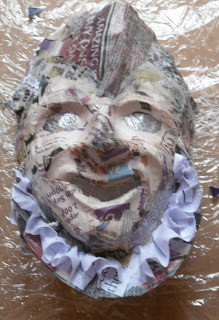 She also says she found it confusing, in parts. It's not just me, then. I'm hoping she'll figure it out, and explain it to me.
She also says she found it confusing, in parts. It's not just me, then. I'm hoping she'll figure it out, and explain it to me.
And Blott's back! So's Ashteroth...
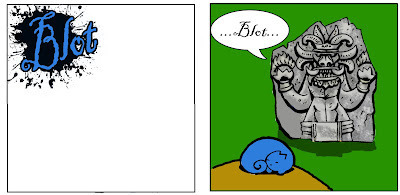
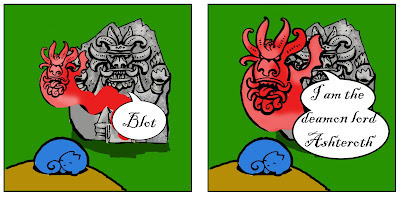
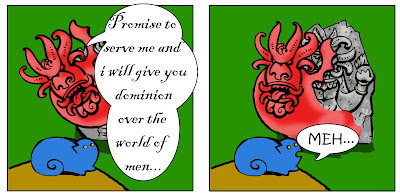
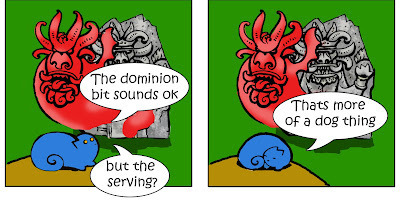

 The mask former
The mask formerStarting with a quote from 'Hamlet', eh? Sure to knock 'em dead.
I was very struck by those lines when I first read 'Hamlet' as a teenager.
I spent a lot of time drawing then, often from life. I knew that, although you might think you were closely observing something, you never really looked at anything until you tried to draw it. The relationships of one part to another, the density of a shadow, the texture, the angles, the precise delination of a curve...
The curves of the Oseberg or Gokstad ships will break your heart. I know: I've tried to draw them.
 The Oseberg Ship Was Shakespeare an artist, then, as well as a playwright?
The Oseberg Ship Was Shakespeare an artist, then, as well as a playwright?But what really brings on these thoughts is my Green Man project. I wrote here some months ago that I'd woken up one morning - without ever having any such thought before in my life as far as I can remember - thinking: 'You should make a Green Man mask out of papier-mache.' And then my brother posted that he'd had much the same thought at about the same time.
Those sort of things tend to stick in your head.
I've been busy, and haven't actually ripped up one bit of paper for the Green Man, but I have been thinking about him a lot. A lot. And one happy side-effect of this has been an increase in the intensity of my observation. When I go out for a walk now, it's not just a bit of exercise in the fresh air - it's research.
I'm perusing things as I would make them.
I'm noticing the different veinings and textures of leaves. Some have plump, pillowy leaves with grooves between the veins. Others are flatter and smoother, but grained. There are pinked edges and smooth edges. Hazel leaves are almost circular, not 'leaf-shaped' at all.
I'm noticing the different ways they spring from their twig or stem; how they grow in rosettes or spirals.
 I'm studying, with great interest, the dead stalks and seed-heads standing in the hedgerows. I've always enjoyed the brilliant red berries, but now I'm seeing how many different shapes of them there are.
I'm studying, with great interest, the dead stalks and seed-heads standing in the hedgerows. I've always enjoyed the brilliant red berries, but now I'm seeing how many different shapes of them there are.I imagine botanists and gardeners enjoy this pleasure in just looking all the time. Perhaps people fascinated by other things do too - people who're enthralled, say, by the study of beetles and other small cattle. But it's a pleasure I'd mislaid somewhat since, all those years ago, I used to stare at things, pencil in hand, hard enough to bore a hole in them.
Whether or not I can reproduce any of these leaves and things remains to be seen - but even if I can't, I'll still have enjoyed this renewed pleasure in just looking. Dying leaves, lemon yellow with splotches and spots of green. Bramble leaves of a deep, glowing maroon red, that you'd think could never be natural, but is.
 In the meantime, I'm approaching the Green Man with due caution, by having a trial run at something else, just to see what I can learn. I'm using a cheap plastic mask (top) as a form. Can you tell what it is yet?
In the meantime, I'm approaching the Green Man with due caution, by having a trial run at something else, just to see what I can learn. I'm using a cheap plastic mask (top) as a form. Can you tell what it is yet?The big news of the week, as far as I'm concerned, is that my agent says that she's enjoying Sterkarm 3, and will be in touch soon, with notes.
 She also says she found it confusing, in parts. It's not just me, then. I'm hoping she'll figure it out, and explain it to me.
She also says she found it confusing, in parts. It's not just me, then. I'm hoping she'll figure it out, and explain it to me.And Blott's back! So's Ashteroth...




Published on October 05, 2012 16:05
September 28, 2012
Climbing the Sterkarm Tower
 Goodrich Castle - knocked about a bit by Cromwell Since my brother was on holiday, and at a loose end, we decided to take a day out together, and revisit one of the castles that we stormed on a regular basis as children, when our Dad did the driving.
Goodrich Castle - knocked about a bit by Cromwell Since my brother was on holiday, and at a loose end, we decided to take a day out together, and revisit one of the castles that we stormed on a regular basis as children, when our Dad did the driving.I was in the driving seat this time, and we went to Goodrich Castle, near Ross-on-Wye. It's an impressive castle, but smaller than we remembered it.
Its defences are formidable, and yet it only had to be defended against the Welsh once. I imagine the Welsh took a long, thoughtful look at the cunningly arranged towers, the barbican, moat and all, and moved on to somewhere easier.
But it was the keep that made the lasting impression on us, the oldest part of the castle, of grey stone, while the rest is of red sandstone. It was built in the mid to late 12th century, and was done on the cheap. Richard De Clare wasn't a favourite with Henry II, it seems, on account of his having sided with Stephen against Henry's Mum, so he was a bit short on funding.
 The grey keep rising above the red towers When I first visited Goodrich, as a child, I'd never heard of a Pele tower. But this keep exactly matched the usual design of a Border Pele tower: three storeys, with the ground floor used for storage, and the two floors above used for living, with a watch-tower on the roof. A single stair in the thickness of the wall was the only way in and out.
The grey keep rising above the red towers When I first visited Goodrich, as a child, I'd never heard of a Pele tower. But this keep exactly matched the usual design of a Border Pele tower: three storeys, with the ground floor used for storage, and the two floors above used for living, with a watch-tower on the roof. A single stair in the thickness of the wall was the only way in and out.So then we climbed the keep, as you do. Well, it was there. And, good lord, I realised that when I'd imagined the Sterkarms climbing their tower stairs, I'd been thinking of bigger castles, and had given them far too much elbow room.
But the Sterkarm tower would have been quite small and built on the cheap too, because the Sterkarms are only farmers, who have to scrabble about for enough money to build their towers, for protection.
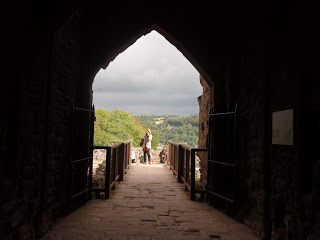 The Gatehouse It shows something of how isolated and backward the debateable lands were, that Goodrich Keep was outmoded by 1300, and used only to host second-rate guests, but the Pele towers were still very similar so much later.
The Gatehouse It shows something of how isolated and backward the debateable lands were, that Goodrich Keep was outmoded by 1300, and used only to host second-rate guests, but the Pele towers were still very similar so much later.I've climbed the stairs in plenty of other towers. I knew they were narrow and twisty. I knew that there wouldn't be room to pass another person on the stairs - well, that was partly the point.
But those stairs at Goodrich! Even in daylight, a section was almost completely dark, and the steps were so narrow that they were more like ledges than steps - and worn ledges at that.
They didn't just twist - they corkscrewed in a tight spiral. It was like turning yourself round on the spot, but climbing up at the same time. And you were touching the walls on either side all time.
And steep! It was like climbing a corkscrewing ladder in the dark - but a corkscrewing ladder with a tight box built round it.
Thank goodness for the stout rope, with large knots, that had been fastened to the central pillar for you to hang on to.
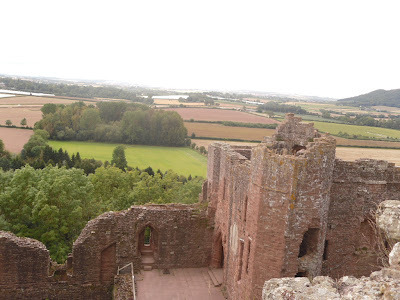 We got to the top, and enjoyed the views over the Wye Valley - but hanging over us was the knowledge that we had to go back down those steps sooner or later.
We got to the top, and enjoyed the views over the Wye Valley - but hanging over us was the knowledge that we had to go back down those steps sooner or later.We wondered how people felt about climbing them on some cold winter's night in 11-umpty-plonk, with nobutt a guttering candle. "I bet they had that rope on the stairs then," I said, "to help them get up."
"They'd have done better," said the bro, "hanging the rope out the window and shinning up and down that way. In fact," he said, warming to his theme, "I can see why Rapunzel was such a popular girl. Abseiling up and down her plaits would have been a sight easier than climbing those stairs."
We did get down - you'll be glad to know that I'm not writing this blog from the top of Goodrich keep. First we put all cameras, sunglasses and other hand-occupying things away in pockets and belt-pouches to have both hands free. We clutched that rope and, in the pitch-dark section, groped about with toes to make sure we found those stone ledges.
"How easy it is to imagine..." You're always hearing this in programmes about anything historical, and it always makes me want to throw things. No! It is not easy at all to imagine what life was like in the past, even when you try hard. We were startled by the claustrophobic narrowness, steepness and darkness of the stairs - but would someone in 1148 have been? Or would they have simply been awed that the keep had stairs at all? - And was built of stone and had three storeys? Or is that making them too unsophisticated?
 It's the same when looking at the castle from outside. Today, we look at impressive ruins, and they're romantic, picturesque, historic... But even if we could see the castle restored to exactly how it would have looked in, say, 1300, we would still be seeing it through modern eyes, within the framework of a modern, democratic, secular understanding.
It's the same when looking at the castle from outside. Today, we look at impressive ruins, and they're romantic, picturesque, historic... But even if we could see the castle restored to exactly how it would have looked in, say, 1300, we would still be seeing it through modern eyes, within the framework of a modern, democratic, secular understanding.It's not easy at all to understand how a fisherman on the Wye, or a farmer in the fields around the castle, would have understood it. Would it have been the stronghold of his oppressors? The home of his employer? The impressive show-home of the local celebrity? The dwelling-place of the God-appointed ruler of that place?
Maybe they saw the castle as a bit of all of the above. Or maybe it was just the everyday and largely ignored background to their lives, as most of the buildings we pass every day are to ours.
But I'm hoping I get a chance to rewrite those Sterkarm staircases.
No Blott this week, I'm afraid. Illness and OU study have combined to keep Blott at home.
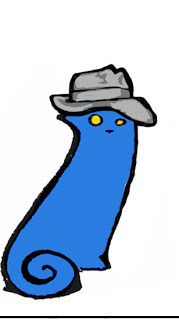
Published on September 28, 2012 16:05
September 21, 2012
Spooky Stories for Switzerland
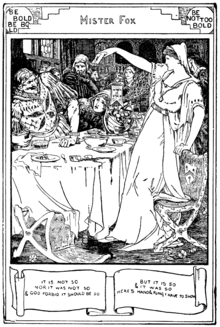 Walter Crane's 'Mr Fox' So, now I haven't got the Sterkarms to keep me occupied, what have I been doing?
Walter Crane's 'Mr Fox' So, now I haven't got the Sterkarms to keep me occupied, what have I been doing?I should have tidied the house, but, of course, I haven't.
I was at the CWIG conference on Sunday, and since then I've been doing admin. I also started my work as an RLF (Royal Literary Fund) Advisor, which so far has meant writing an email to the four new RLF Fellows that I have in my pastoral care, so to speak. The poor unfortunates. It was an email to wish them luck in the year ahead, but also passing on all the tips I picked up while doing the job. So it took a long time to write, and to sort out all the things I wanted to attach.
And I've been revising the 'spooky' stories which I intend to tell to my cousin's classes in Switzerland, via webcam.
Choosing the stories was fairly simple. I've decided on 'Mr. Fox' - usually a show-stopper - and 'The Haunted Room.'
I've had to bear in mind that the children's first language is German - well, Platt-Deutsch, or Swiss German. So I've tried to keep the language quite simple without losing the story's power.
The famous rhyme gives me problems:
'Be Bold, Be Bold,, Yet not so Bold, Lest Thy Heart's Blood Should Run Cold.' It's a bit archaic - but will it work as well if modernised?
'In case your heart's blood' sounds lame. But 'For fear your heart's blood' is still quite old-fashioned. I shall have to consult with my cousin, Alan Hess. He's the one who knows about teaching languages.
The other story, 'The Haunted Room' I've given a modern setting, though it's an old story. The only problem with it is that I don't know if German children will understand a 'pub'. A pub in which you can 'put up' for the night, too.
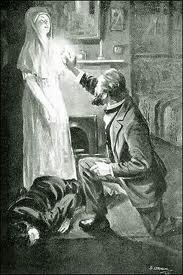 Besides revising the stories - which I've enjoyed - I've also been trying to learn to use my new web-cam, which isn't as straight forward as I thought it would be.
Besides revising the stories - which I've enjoyed - I've also been trying to learn to use my new web-cam, which isn't as straight forward as I thought it would be.The camera itself is fine, though I can see I'm going to have to go to some trouble to get the lighting right.
The problem was the sound. Couldn't get it to record sound at all. There I was, mouthing 'Mr. Fox' like a goldfish that wants to make your flesh creep.
I looked up 'help' - I searched on the internet and followed instructions. Still nothing but silent movies.
While Davy watched the television beside me, I fiddled and fiddled with the webcam until I found yet another drop-down menu. The thing seems to have dozens of menus hidden in unexpected places - you can use some to put moustaches and silly hats on yourself, or make lighting flash behind you. Don't think I'll be using any of them.
But I found this new menu, ticked an hitherto unsuspected box - and success! My bronchial, nasal, hoarse Black Country muttering could be heard.
Davy read that over my shoulder, and said, "You don't sound at all like that, not at all, not at all." King o' De Nile. It's all right for him, with his purring Fife accent, which everybody loves. Nobody loves a Black Country accent, especially if it sounds like you need an inhaler.
I suppose one advantage of telling stories to people who don't speak English very well, is that they won't understand, either, that 'as soon as an Englishman opens his mouth, another Englishman despises him,' as Shaw said.
I spoke to a class of German children once, who were baffled that I hadn't met the Queen. They obviously thought that she dropped in on her subjects every few days.
I don't know if the Swiss children think the same; but at least they'll learn that we don't all talk like her.
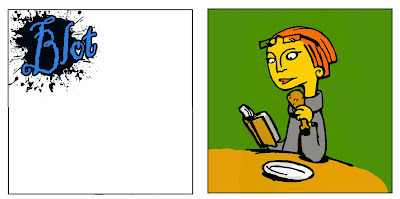
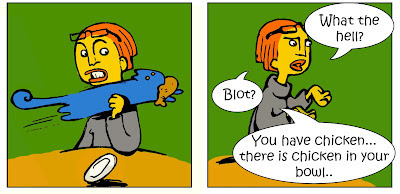
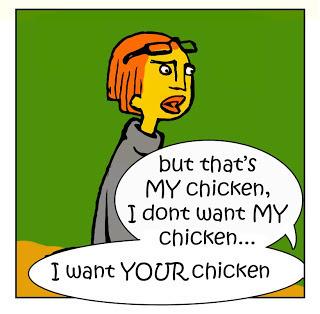
Published on September 21, 2012 16:05
September 14, 2012
September
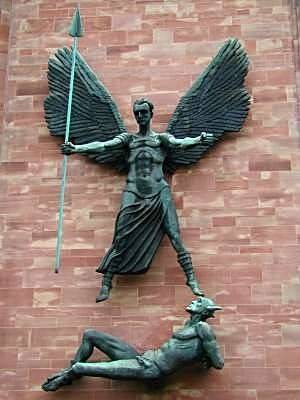 Epstein's St. Michael, Coventry Cathedral September. A great time of year. I was out walking today, in the sun, but seeing dead seed-heads, and blackberries, and the leaves turning colour. I enjoyed the mad whippets' account of rambling and brambling (I didn't know whippets were so fond of blackberries.)
Epstein's St. Michael, Coventry Cathedral September. A great time of year. I was out walking today, in the sun, but seeing dead seed-heads, and blackberries, and the leaves turning colour. I enjoyed the mad whippets' account of rambling and brambling (I didn't know whippets were so fond of blackberries.)September's big day is the 29th, which is Michaelmas, the feast of Heaven's Captain, Saint Michael, the warrior Archangel, who doesn't mess about with turning the other cheek, but adopts a more robust approach to defending us from Darkness and Evil, with a spear. Somebody's got to do it. You can imagine him tapping his fingers and sighing a lot through those long meetings in Heaven.
I've always had a fondness for St Michael, probably because I suspect Him of being someone pagan, thinly disguised.
His feast day is one of the four quarter days, which mark the turnings of the year, and which were always celebrated with feasts and fairs. And there was never any pretence that Michael had ever been human, as there was with, say, Saint Christopher or Saint Bridget. Michael was always supernatural, an Archangel, no less.
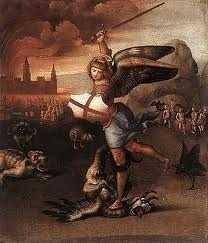 St Michael by Raphael He is the patron saint of horses and horsemen. Hmm. Horses were sacred to the Norse God Freyr (who was also a young warrior, often identified with Christ in the early years of Northern Christianity. 'Freyr' is a title, not a name: it means 'Lord', and there was some confusion about which Lord the Christians were talking about.) Horses also seem to have been venerated by the people we loosely call 'the Celts'.
St Michael by Raphael He is the patron saint of horses and horsemen. Hmm. Horses were sacred to the Norse God Freyr (who was also a young warrior, often identified with Christ in the early years of Northern Christianity. 'Freyr' is a title, not a name: it means 'Lord', and there was some confusion about which Lord the Christians were talking about.) Horses also seem to have been venerated by the people we loosely call 'the Celts'.Michael is usually represented with a lance or spear - often with the Devil stuck on the other end of it. Again, hmm. A spear was the symbol of the Norse God Odin, but a better match is probably the God who survives in the old Irish stories, Lugh of the Spear.
Did Michael find a welcome and lasting place in British tradition because there was an empty niche - very suitable for a Saint - waiting for Him? The Church might say there was only one God, but was there a collective sigh of relief when Michael turned up? Oh, there He is. Been wondering where He'd got to.
 Michael's daisies And then, He has Michaelmas Daisies. I've always loved them.
Michael's daisies And then, He has Michaelmas Daisies. I've always loved them.But Old Michaelmas Day - before the calendar was changed - was October 10th. I hope the whippets avoid blackberrying on that day and after because - so I was told - the Devil will come and hold the branches down for them to reach. No good ever comes of accepting help from Old Nick.
Another version is that He makes it His personal mission to spit on each and every blackberry left on the bushes on October 10th. A doddle, I suppose, when you are the great Lord of Evil. And being poked with a spear every September must make you crotchety.
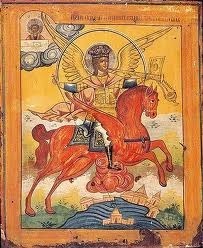 Icon of St. Michael, patron of horses As a child, I was never told why Old Nick had such a spite against blackberries - I assumed it was all part of his general grudge against the world - but it seems that when He was thrown out of Heaven, He fell into a blackberry patch. I can see how that would put you off them.
Icon of St. Michael, patron of horses As a child, I was never told why Old Nick had such a spite against blackberries - I assumed it was all part of his general grudge against the world - but it seems that when He was thrown out of Heaven, He fell into a blackberry patch. I can see how that would put you off them.Happy Michaelmas! And I hope you have a jug of michaelmas daisies.
And here's a suitably supernatural Blott... Cover Brother Andrew dropped by my house today, just as I downloaded this week's Blott, but fought off all attempts to show it to him, because he wanted to see it for the first time, in its proper place, at the end of this blog in the early hours of Saturday morning.
I love this Blott - but I want to see Demon Lord Ashteroth again!
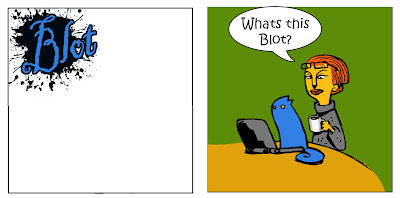


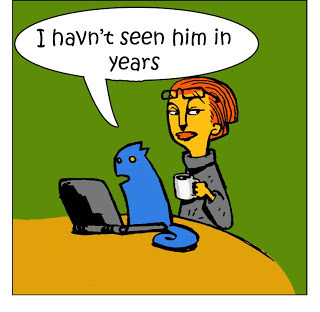
Published on September 14, 2012 16:05
September 7, 2012
I Did It!
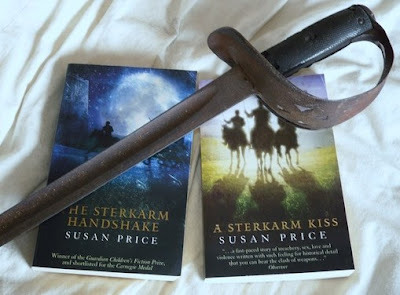 Friday 7th September 2012
Friday 7th September 2012 I did it, I did it!
Three years to the month since I started, I've finished Sterkarm 3 and sent it to my agent just one hour ago.
Now what do I do?
Whatever, it has to be do-able one-handed. The doc's anti-inflammatories have done wonders for all my other joints - I am bounding up stairs and hills with lightsome foot - but left the tendonitis in my right hand and arm untouched. When I finished the Sterkarm book last night, my right wrist was visibly swollen.
Still, it's forced me to remember many tricks, such as:
Cntrl + C = CopyCntrl + V = PasteCntrl + X = DeleteCntrl + S = Save A double click on a word selects it for copying or deletion.
All these enabled me to do a lot left-handed - quite suitable for writing about the Sterkarms! - in one corner of the key-board.
So I'm afraid that's all for this post -
But good wishes to all and any struggling with finishing a book! Be of good cheer! It does, eventually, end.

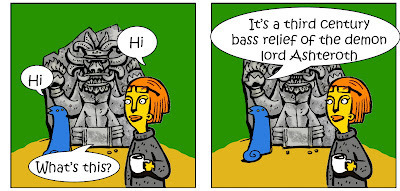
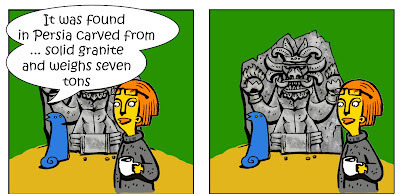

Published on September 07, 2012 16:05
August 31, 2012
Sterkarm Report
Well, I failed. It's 7-30pm on Friday night, and I know now that I'm not going to have Sterkarm 3 with my agent by tomorrow, September 1st.
I tried hard. I finished the book. I'm a lot further on than if I hadn't set the deadline - but I'm going to have to ask for an extension. Wednesday 5th seems a reasonable goal.
What I still have to do is a final read through, while removing all the headings which helped me find my way around in 138,000 words. I'm about a quarter of the way through, on Chapter 10.
What's held me up? Well - violins, please - a flare-up of tendonitis has not helped. I am pecking out this blog with my left hand. My right arm in a sling because it's so uncomfortable and at least, in a sling, it aches a little less. It hurts to pick up an envelope right-handed.
This slowed me down - and I had to spend time at the doctor's, getting some anti-inflammatory tablets.
Happier interruptions - I sold a book through my website's new book-store, and had to pack up the book and post it. Thank you, kind person. The book is on its way.
Also my cousin phoned from Switzerland, to ask, could he book me to tell spooky stories in November, to the kids in his Swiss school - via webcam and Skype? Now this is something I've been thinking about for a while, and Alan has given me a useful shove. I shall resurrect my Skype account, get a webcam, and learn to use it. And then I shall offer virtual school visits - and maybe one-to-one writing advice via webcam, instead of just e-mail.
Get me - the virtual writer.
And here, especially dedicated to all those of you out there wrestling with edits, is Blott.
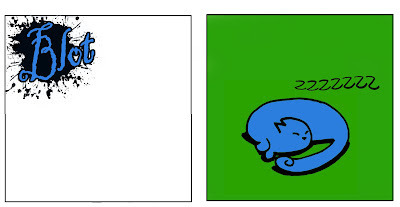
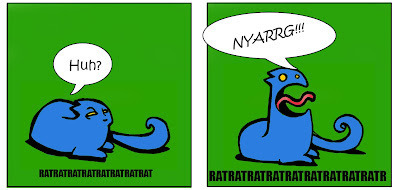
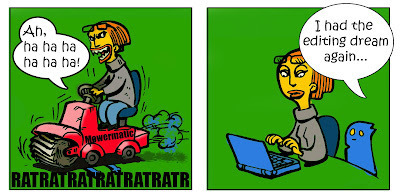

I tried hard. I finished the book. I'm a lot further on than if I hadn't set the deadline - but I'm going to have to ask for an extension. Wednesday 5th seems a reasonable goal.
What I still have to do is a final read through, while removing all the headings which helped me find my way around in 138,000 words. I'm about a quarter of the way through, on Chapter 10.
What's held me up? Well - violins, please - a flare-up of tendonitis has not helped. I am pecking out this blog with my left hand. My right arm in a sling because it's so uncomfortable and at least, in a sling, it aches a little less. It hurts to pick up an envelope right-handed.
This slowed me down - and I had to spend time at the doctor's, getting some anti-inflammatory tablets.
Happier interruptions - I sold a book through my website's new book-store, and had to pack up the book and post it. Thank you, kind person. The book is on its way.
Also my cousin phoned from Switzerland, to ask, could he book me to tell spooky stories in November, to the kids in his Swiss school - via webcam and Skype? Now this is something I've been thinking about for a while, and Alan has given me a useful shove. I shall resurrect my Skype account, get a webcam, and learn to use it. And then I shall offer virtual school visits - and maybe one-to-one writing advice via webcam, instead of just e-mail.
Get me - the virtual writer.
And here, especially dedicated to all those of you out there wrestling with edits, is Blott.



Published on August 31, 2012 16:05
Susan Price's Nennius Blog
"I have made a little heap of all I've found..."
"I have made a little heap of all I've found..."
...more
- Susan Price's profile
- 71 followers



